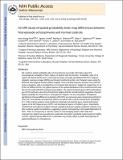| dc.contributor.author | Park, Hae-Jeong | |
| dc.contributor.author | Levitt, James Jonathan | |
| dc.contributor.author | Shenton, Martha Elizabeth | |
| dc.contributor.author | Salisbury, Dean F | |
| dc.contributor.author | Kubicki, Marek R. | |
| dc.contributor.author | Kikinis, Ron | |
| dc.contributor.author | Jolesz, Ferenc A. | |
| dc.contributor.author | McCarley, Robert William | |
| dc.date.accessioned | 2016-09-27T19:41:31Z | |
| dc.date.issued | 2004 | |
| dc.identifier.citation | Park, Hae-Jeong, James Levitt, Martha E Shenton, Dean F Salisbury, Marek Kubicki, Ron Kikinis, Ferenc A Jolesz, and Robert W McCarley. 2004. “An MRI Study of Spatial Probability Brain Map Differences Between First-Episode Schizophrenia and Normal Controls.” NeuroImage 22 (3) (July): 1231–1246. doi:10.1016/j.neuroimage.2004.03.009. | en_US |
| dc.identifier.issn | 1053-8119 | en_US |
| dc.identifier.uri | http://nrs.harvard.edu/urn-3:HUL.InstRepos:28559577 | |
| dc.description.abstract | We created a spatial probability atlas of schizophrenia to provide information about the neuroanatomic variability of brain regions of patients with the disorder. Probability maps of 16 regions of interest (ROIs) were constructed by taking manually parcellated ROIs from subjects’ magnetic resonance images (MRIs) and linearly transforming them into Talairach space using the Montreal Neurological Institute (MNI) template. ROIs included temporal, parietal, and prefrontal cortex subregions, with a principal focus on temporal lobe structures. Subject Ns ranged from 11 to 28 for the different ROIs. Our global measure of the spatial distribution of the transformed ROI was the sum of voxels with 50% overlap among subjects. The superior temporal gyrus (STG) and fusiform gyrus (FG) had lower values for schizophrenic subjects than for normal controls, suggestive of greater spatial variability for these ROIs in schizophrenic subjects. For the computation of statistical significance of group differences in portions of the ROI, we used voxel-wise comparisons and Fisher's exact test. First-episode schizophrenic patients compared with controls showed lower probability (P < 0.05) at dorso-posterior areas of planum temporale and Heschl's gyrus, lateral and anterior regions in the left hippocampus (HIPP), and dorsolateral regions of fusiform gyrus. Importantly, most ROIs of schizophrenic subjects showed a significantly lower spatial overlap than controls, even after nonlinear spatial normalization, suggesting a greater heterogeneity in the spatial distribution of ROIs. There is consequently a need for caution in neuroimaging studies where data from schizophrenic subjects are normalized to a particular stereotaxic coordinate system based on healthy controls. Apparent group differences in activation may simply reflect a greater heterogeneity of spatial distribution in schizophrenia. | en_US |
| dc.language.iso | en_US | en_US |
| dc.publisher | Elsevier BV | en_US |
| dc.relation.isversionof | doi:10.1016/j.neuroimage.2004.03.009 | en_US |
| dc.relation.hasversion | https://www.ncbi.nlm.nih.gov/pmc/articles/PMC2789267/ | en_US |
| dash.license | LAA | |
| dc.subject | MRI | en_US |
| dc.subject | schizophrenia | en_US |
| dc.subject | brain | en_US |
| dc.title | An MRI study of spatial probability brain map differences between first-episode schizophrenia and normal controls | en_US |
| dc.type | Journal Article | en_US |
| dc.description.version | Accepted Manuscript | en_US |
| dc.relation.journal | NeuroImage | en_US |
| dash.depositing.author | Shenton, Martha Elizabeth | |
| dc.date.available | 2016-09-27T19:41:31Z | |
| dc.identifier.doi | 10.1016/j.neuroimage.2004.03.009 | * |
| dash.identifier.orcid | 0000-0003-4235-7879 | en_US |
| dash.contributor.affiliated | Jolesz, Ferenc | |
| dash.contributor.affiliated | Kikinis, Ron | |
| dash.contributor.affiliated | Kubicki, Marek | |
| dash.contributor.affiliated | Levitt, James | |
| dash.contributor.affiliated | Shenton, Martha | |
| dash.contributor.affiliated | McCarley, Robert William | |
| dc.identifier.orcid | 0000-0001-5705-7495 | |


